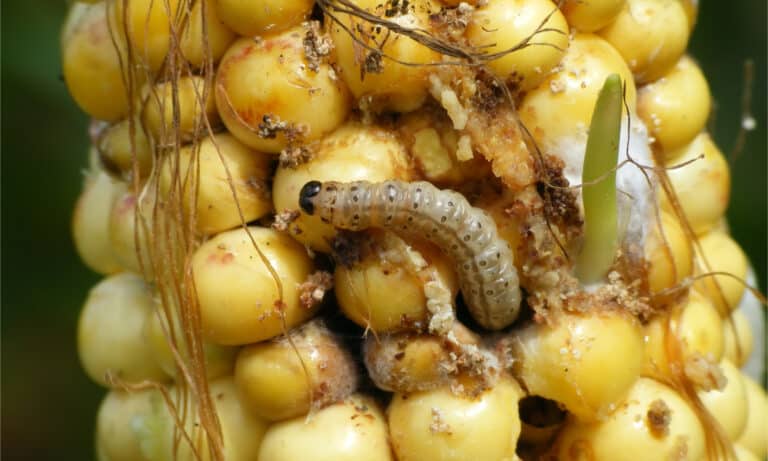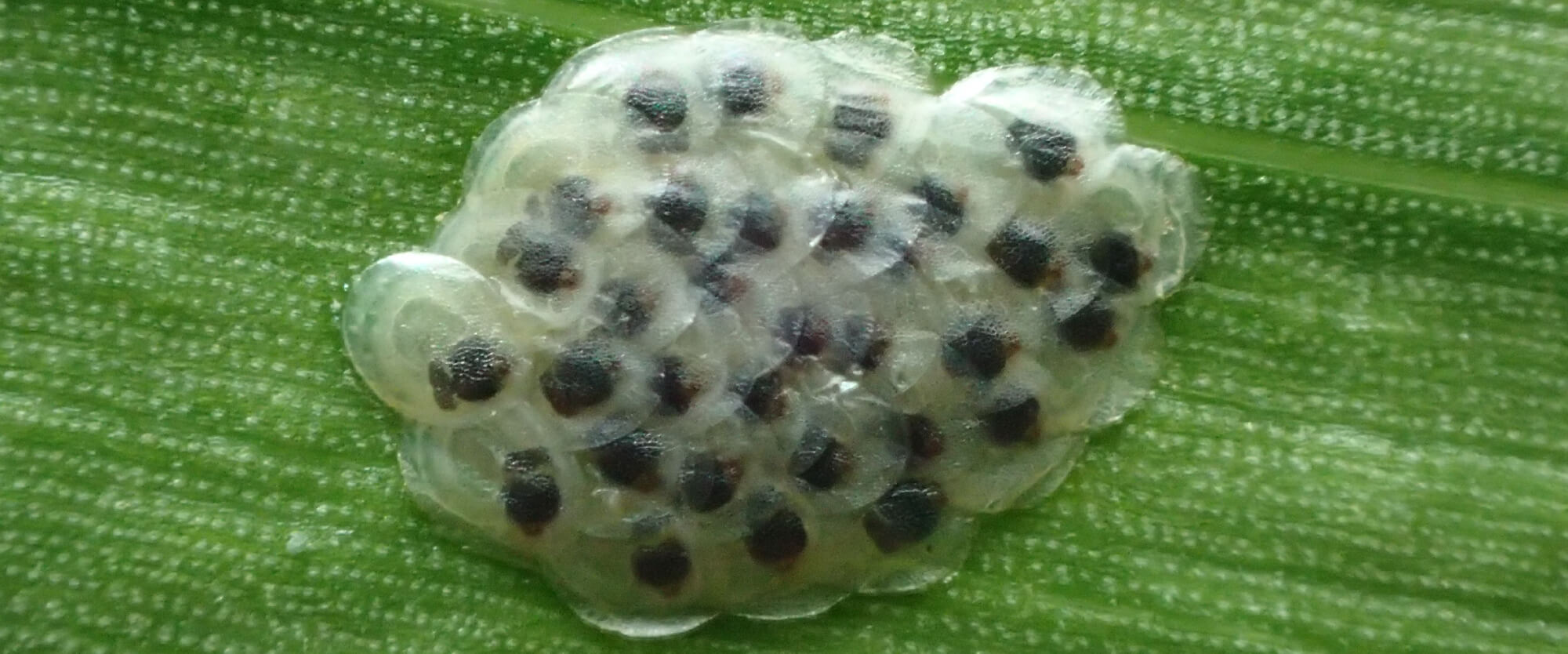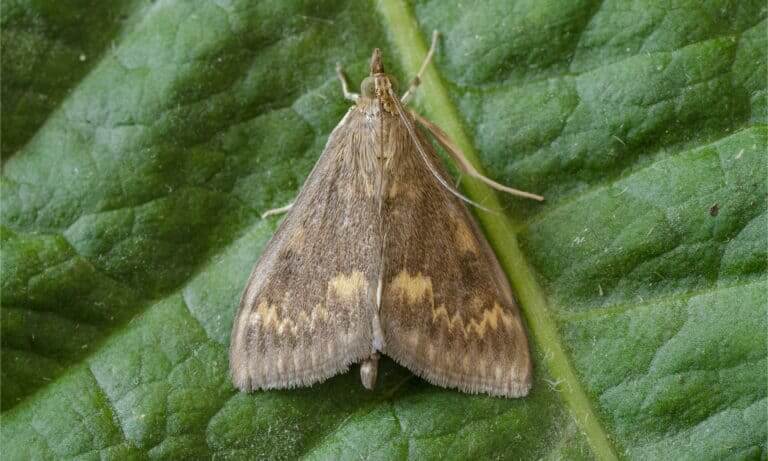European Corn Borer
Ostrinia nubilalis
Although the widespread adoption of corn hybrids expressing Bt traits has greatly reduced the economic impact of European corn borer in field corn and simplified management, there is still a need to monitor and control infestations in refuge plots and any fields planted to non-Bt varieties.
|
European corn borer mass of eggs up close. Photo by: Tomasz Klejdysz |
 Larva present on corn. Larva present on corn. |
|
Adult european corn borer. Photo by: DJ Taylor |
Control measures
Control measures are advisable in non-Bt cornfields only when 50 percent of plants are infested with an average of one or more larvae. Any insecticide must be applied early in the infestation while larvae are small and confined to the whorl area. Granules should be applied directly over the planted rows so they enter the whorls of the plants. However, granular products have given inconsistent results in K-State experiments. Similarly, liquids should be sprayed so that material is delivered into the whorl if ground equipment is used. Reports indicate that some products work better when applied with high volumes of water; some products are labeled for chemigation. Retreatment within 7 to 14 days may be necessary if moths continue to lay eggs.
Control of second generation European corn borer is typically more important than control of the first generation in Kansas. Second generation moths emerge over an extended period during July and August and lay eggs on corn in the silking stage. It is more difficult to scout egg masses on large plants, and determine the extent and intensity of infestations. Yield loss can result from a variety of factors including physiological damage caused by larval tunneling, and harvest losses due to lodged stalks, ear droppage, and direct kernel feeding.
Research has demonstrated that corn plants have significant ability to compensate for boring damage to vascular bundles by re-routing water transportation higher up in the plant; however, bottlenecks to compensation appear to occur at the leaf collar, leaf sheath, and ear shank locations. Other research indicates that shank tunneling by larvae can cause significant ear droppage. Ear droppage will accelerate if shank-infested plants remained unharvested for three or more weeks following physiological maturity (black layer formation). Fields in which European corn borers infest a significant percentage of ear shanks should harvested as early as feasible.
Some data suggest that shank tunneling larvae may contribute as much, or more, to physiological yield loss as larvae tunneling stalks. Other data indicate that fields with grassy weeds and those infested with shattercane may be susceptible to heavier infestations. Grasses serve as resting and mating sites and help maintain humid microclimates, all of which can increase corn borer infestations. Control of weeds before second generation moths deposit eggs will reduce the probability of synergistic losses resulting from the combined stresses of weeds and insects.
The threshold for treating second generation is generally between 10 to 20 egg masses per 100 plants, but varies with the expected price of the crop. Egg mass counts should include both hatched and unhatched egg masses. Sampling should be conducted intensively within 10 to 12 days after the first eggs are detected. Typically, 70 to 85% of eggs are laid on the seven leaves nearest the ear (ear leaf and three leaves above or below) and 5% of oviposition will have occurred by the time the first egg masses are found. Given that the egg laying period lasts about 3 weeks, about 50% of eggs will have been laid about 8 days after the first eggs are found. Samples should be taken from at least 4 locations in a field to be representative.
Sprays should not be applied on the basis of calendar dates or the stage of corn development. Inspect fields at least once a week during the period of second generation activity (roughly mid-July through August). Inspections may need to be made two or three times a week during periods of peak moth activity, especially in fields of silking-stage corn. 50% of plants with one or more exposed larva is justification for treatment. When the economic threshold is reached, treatment should be made as eggs begin to hatch and larvae are visible in the leaf axils, generally within five to six days of peak egg deposition. Keep in mind that insecticides will not be effective once larvae bore into the stalk or ear shank. If fresh eggs are still observed seven to 10 days after the first application, a second application may be justified. Fields that exceed treatment thresholds early in the oviposition period are more likely to benefit from a second application; if the threshold is not reached until late in the ovipostion period, one application is more likely to give adequate control.Treatments should remain effective as long as a majority of larvae are still small and feeding in exposed areas around leaf sheaths. Two applications are frequently necessary to suppress second-generation infestations. Good coverage above, below, and around the ear zone is essential to obtaining control. Keep in mind that many older (and hence cheaper) insecticides registered for corn borer have the potential to disrupt biological control of spider mites, and thus increase mite problems, which should be a consideration whenever selecting insecticides for corn borer control. Be cautious in using broad spectrum materials such as organophosphate and pyrethroid insecticides that will kill predatory mites, while leaving spider mite populations intact in untreated areas.
For more information regarding corn borers, click here.
Please consult the most recent Corn Insect Management Guide for more information on corn borer management.
Page last updated 4/2/2024 by J.P. Michaud.

